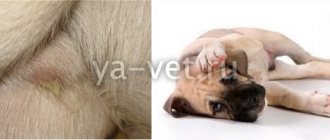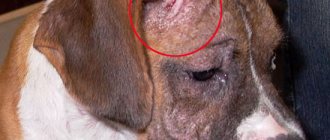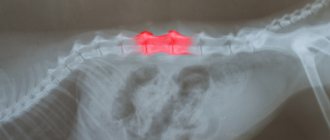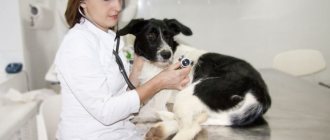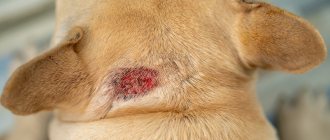Ascites is the most severe pathology of dogs, which occurs as a result of some abnormal process on the part of the internal organs. The condition is dangerous because a large amount of fluid accumulates in the abdominal cavity. In average dogs, the volume can reach up to 10 liters or more. If ascites is left unattended, it will threaten the animal’s life. Let's look at what most often causes ascites in a dog. How to determine what exactly is fluid in the abdominal cavity, what measures to take and whether it is possible to save the animal or extend its life.
What is ascites in dogs
An alternative name for this disease is dropsy. With it, dogs experience excess fluid accumulation in the abdominal cavity. The resulting excess increases internal pressure, disrupting the functions of the gastrointestinal tract.
Speaking about what ascites is in dogs, it is important to note that it is not an independent disease and is always a consequence of more dangerous pathologies. Its appearance is provoked by inflammatory and non-inflammatory processes that impair blood circulation and absorption.
Owner stories
Tatyana : “At first, our dog began to lose weight, although she ate as usual. We went to the clinic, where we heard a disappointing diagnosis - there was a malignant neoplasm in the liver. After some time, I noticed that the dog’s belly had become enlarged. We went to the doctor again. The dog had an ultrasound and the doctor said that all organs were “floating” in ascites fluid. Immediately after the study, the fluid was pumped out, but the doctor warned that this condition would recur. Every 2 months we came to pump out this liquid. They gave me medications to stabilize my condition and diuretics. A year later, our dog was gone.”
Vadim : “My male dog was 12 years old. I began to notice that he breathes through his mouth all the time, even when it is not hot and when he is calm. I called a doctor, he took blood tests, but all the main indicators were normal. Then the dog was prescribed another heart test and it turned out that he had developed heart failure. They prescribed heart medications, I gave them to the dog at home with food. Six months later, the condition worsened again - again he was breathing heavily, did not eat, and his stomach was still swollen. We went to the clinic, it turned out that ascites had been added to the heart problems. The doctor explained how to deal with the problem - periodically pump out the fluid. So I came once a month for this procedure. The dog got worse each time and he had to be euthanized.”
Causes of the disease
The causes of dropsy in dogs include congenital and acquired diseases, accompanied by the formation of transudate and exudate (edematous fluid). Both types accumulate in tissues and body cavities, causing disruptions in the functioning of internal organs throughout the body.
Most often in animals with ascites the following is found:
- Abdominal injuries causing internal bleeding, swelling or inflammation.
- Infectious and parasitic diseases. Any pathogenic microorganism releases toxins during its life processes. In response to this, the body launches an inflammatory response.
- Neoplasms of various etiologies. A sudden rupture of a cyst can result in peritonitis, an inflammation of the peritoneum. It is also possible that natural blood circulation may be disrupted due to the growth of cancer cells. They block lymphatic vessels and increase their permeability.
- Heart pathologies. Problems with blood circulation occur with heart failure and other disorders that lower the heart rate.
- Kidney and liver diseases. Due to disruption of the filtration function, all toxins and breakdown products accumulate inside the body, causing inflammation of other organs and systems.
- Hormonal disorders. The problem often occurs in animals that are overweight and have high cholesterol levels. Both factors provoke the development of diabetes mellitus.
Another possible reason is poor nutrition. The risk group includes pets with vitamin deficiency, protein deficiency and sodium excess.
You might be interested
Diarrhea in a dog - how to treat it and why it occurs
Diarrhea or diarrhea in a dog is a very annoying phenomenon. On top of everything else, it can greatly …read more
What is a dog's normal body temperature and how to measure it
The easiest way to determine the well-being and health status of a dog is to measure its temperature. But you need to take into account that ...read more
The dog sheds a lot - should you worry and what to do?
When purchasing a dog for home, you should be prepared for any “surprises”, including periodic shedding ...read more
Main symptoms of ascites in dogs
Symptoms and signs of hydrops in dogs that appear early are often confused with pregnancy and obesity. All these conditions are united by a rounded belly, which arouses suspicion only among the most attentive owners. For this reason, help is usually sought a little later - when the symptoms are complemented by the appearance of:
- poor appetite, which is not reflected in weight (despite the visible ribs and spine, the number on the scale does not change due to the amount of fluid);
- dull coat;
- shortness of breath during physical activity and at rest;
- extreme thirst;
- yellow or blue mucous membranes;
- swelling in the groin area, base of the ears, paws and chest;
- apathetic state with reduced activity (the animal is often in a sitting position);
- copious and frequent urination.
In the absence of recent mating, compliance with the feeding regime and sufficient mobility, veterinarians recommend conducting a special test. With its help, you can refute the imminent addition to the four-legged family and overeating.
To do this, you need to lift your pet by its front paws and watch its stomach. During stagnation, the round shape will change to a pear-shaped one, as all the liquid will rush down.
The clinical picture directly depends on the cause and stage of the pathology, therefore, in addition to the listed symptoms, diarrhea, vomiting, high fever, cough and severe pain may occur. To avoid complications, the animal should be shown to a doctor soon after a deterioration in appetite and loss of usual activity.
Clinical signs
In a dog with ascites, you can observe not only a swollen belly. A sick animal cannot breathe freely , and it is difficult for her to inhale due to the intense tension of the inspiratory muscles, but exhalation is not difficult.
With this disease, the animal may experience problems in the gastrointestinal tract in the form of:
- Constant constipation.
- Diarrhea.
If an animal develops dropsy of the brain, it does not remain in a conscious state for a long time; the clinical picture in such a case is expressed in the form of coma or lethargy. When his pet coughs, the owner can hear the gurgling of the liquid in it.
Due to the occurrence of ascites, the pet develops anorexia . During illness, the animal eats practically nothing; against the background of excessive thinness, the huge belly is very noticeable.
Carrying out diagnostics
If a home test for ascites is positive, do not rush to self-medicate. Treatment methods directly depend on the cause of the disease, so a full examination cannot be avoided. The veterinary clinic will need:
- take urine and blood tests;
- undergo an ultrasound and x-ray;
- make a puncture.
Based on the results, the doctor determines the presence of diseases of the urinary system, injuries and tumors, the level of intoxication, the degree of organ damage, the exact amount and composition of the effusion. Next, the four-legged patient is given an individual treatment plan that takes into account the diagnosis.
How to protect your pet?
There are no preventive measures against abdominal hydrops. You should visit a veterinary hospital in a timely manner and get tested regularly. This will allow you to immediately identify diseases in your pet.
A sick dog needs extra attention. If surgical intervention is necessary, it is important to agree with the doctor so as not to risk the life of your pet. After surgery, active therapy is required.
The veterinarian will provide a list of necessary medications, give instructions, and nutritional recommendations. Owners must understand that the health of the animal depends on their care and love. Self-medication with human medications should not be practiced.
Therapy methods
Treatment for ascites in dogs involves treating the underlying cause, relieving symptoms, and removing excess fluid. The first point is the most important, since without it symptomatic therapy gives only a temporary effect.
Medication
When sepsis and hypoxia are detected, blood transfusions and oxygen therapy are used, but most often treatment is limited to medication. Excess fluid is removed with diuretics, and all other drugs are selected individually:
- cardiotonics that stimulate the heart;
- antibiotics that destroy the causative agent of the detected infection;
- immunomodulators that prevent secondary infection by viruses or bacteria;
- analgesics that suppress attacks of pain;
- antiemetics, eliminating nausea and vomiting;
- sedatives and antipyretics;
- colloidal solutions that normalize protein levels.
Safe dosages and procedures for taking medications are determined by your veterinarian. They may differ from the instructions inside the package, since many medications are intended for human use.
Surgical intervention
Surgical treatment of dropsy in dogs is used when there is extremely high internal pressure and there is no effect from taking medications. In both cases, laparocentesis, or abdominal puncture, is used. In this procedure, effusion is drained through a small puncture in the abdomen. During the manipulations, the animal is under general anesthesia.
Also, indications for surgical intervention are necrosis, abscesses, internal bleeding and malignant neoplasms that do not have metastases. In these cases, treatment comes down to excision of dead tissue, cleansing of the purulent cavity, restoration of damaged tissue, or removal of the tumor.
Auxiliary folk remedies
Traditional medicine is used exclusively to eliminate symptoms. The recipes used are not able to affect the ascites itself, so in no case limit yourself to them.
Attention!
Many animals are prone to grass allergies. To be safe, use infusions and decoctions only under the supervision of a veterinarian.
Prevention
Prevention of ascites consists of general measures:
- balanced healthy diet;
- good living conditions;
- quarterly treatment for parasites (worms, fleas, ticks);
- routine vaccination;
- annual examinations by a doctor (especially for animals after 7 years).
Animal care and diet
During the treatment of ascites, it is recommended to reduce the duration of walking, increasing its frequency. Moderate activity and timely emptying will reduce the load on the heart, lungs and bladder. You will also need to put your pet on a temporary diet that includes:
- eating high-protein foods, boiled or steamed;
- reducing the amount of salt and water;
- taking vitamin and mineral complexes approved by a veterinarian.
With dry feeding, you will have to switch to a medicinal line designed for animals with sensitive digestion. To avoid allergies or diarrhea, it is better to choose food from a manufacturer you already know.
What to feed
If the appetite is preserved, then the dog is given food rich in protein. It could be chicken or turkey breast. They are pre-boiled or simply doused with boiling water. Carbohydrates and fats are reduced to a minimum. For porridges, you can add a little buckwheat or rice. Salt is completely excluded.
Appropriate industrial therapeutic diets are prescribed if the underlying disease is identified.
The dog's fluid intake should be reduced by pouring smaller amounts into the bowl and limiting access to water sources.
Choosing a veterinary clinic
We determine the veterinary clinic where you plan to go. A big PR company doesn't promise quality. The price is explained by the huge amount of money invested in advertising and “signboarding” of the establishment.
It’s great if you can ask your friends about clinics where their pets were treated “humanely.” If you travel far from them, it may be worth sacrificing time for the health of your pet.
A few more tips on how to spot an unverified veterinary clinic:
- Refusal to provide certificates and licenses for veterinary activities.
- Strange and suspicious behavior of the veterinarian (inconsistency, flattery, attempts to intimidate, shouting).
- Prices are too low (compared to other organizations).
- Refusal to freely visit the veterinary clinic.
“We have a sanitary day”
Beware of scammers!
When you contact the veterinary clinic, you are informed: “we cannot accept you at this address, sanitary day/repair/inspection.” How much intelligence does a dispatcher have? The client is persuaded to have a veterinarian come to his home. The price does not change.
A veterinary clinic can exist purely nominally. And the invited “Aibolit” will not bear responsibility. There is a high probability of running into a person without a veterinary diploma or simply an unprofessional.
It is better to find time to visit the veterinary clinic on your own. This is safer for the animal.
Treatment
Dropsy is a consequence of a disease; in order to cure it, it is necessary to get rid of the cause of the disease. Treatment of primary pathology is carried out after its diagnosis. But since diagnosis takes some time, symptomatic therapy is prescribed even before the examination is completed.
Medication
When a significant amount of fluid accumulates, the surgeon pierces the peritoneal wall and removes it.
If the disease does not develop pathologically, then complex therapy with drugs is prescribed:
- Diuretics: Nephropil, Canephron.
- Antibiotics are used to relieve inflammation: Trimethine, Cephalosporin.
- Vitamin complexes are prescribed.
- Hypoprotectors are used: Heptarl, Ursofalk.
- To strengthen the heart, use: Hydrochlorothiazide, Chlortizide.
- During the necrosis of cardiac tissue, the animal is placed in an oxygen chamber.
Folk
If the disease is not caused by severe changes in the internal organs and if the doctor allows the treatment of dropsy with medicinal plants, then the following recipes are used:
- Mix coltsfoot and bean pods with angelica and dried apricots. Brew everything in 1 liter of boiling water, let it brew and take the composition within 24 hours.
- Mix equal amounts of currant leaves, sage and chamomile. Pour the ingredients into 1 liter of boiling water and leave to steep for 25 minutes. Decant and take within an hour.
- Add 1 tbsp to 250 g of milk. fresh parsley, and place in the oven, preheated to 85 degrees. The composition must be simmered over low heat until half the volume has evaporated. The product should be given to the dog once a day.
Tactics
Before starting treatment, the doctor prescribes the following tests - ultrasound, x-ray, sampling of abdominal fluid for tests.
Based on the data obtained, a diagnosis is made and appropriate therapy is prescribed, which is aimed at eliminating the causes of ascites.
The dosage and methods of use of drugs that relieve the main symptoms of the disease are determined by the veterinarian.
Drugs
The most commonly prescribed medications are:
- Losartan;
- Veroshpiron;
- Furosemide;
- Eufillin.
In advanced cases of ascites, laparocentesis (pumping out fluid from the abdominal cavity) is prescribed. This procedure can significantly alleviate the dog’s condition and is carried out in parallel with taking medications. Additionally, the veterinarian may recommend taking antibiotics and protein drugs.
Methods
Depending on the disease causing ascites, the following treatment methods are also used:
- taking diuretics helps remove harmful substances from the animal’s body;
- taking cardioprotectors and hepaprotectors stabilizes the functioning of the heart muscle and liver;
- diet with limited salt and liquid.
Prepare before going to the vet
In the office, you may have to provide the veterinarian with all possible assistance (hold the animal while they take blood for analysis, give an injection, extinguish aggression, calm your voice, scratch its ears, stroke it). If you know that you are terrified of blood, IVs, or definitely cannot withstand the type of medical interventions, then perhaps you should ask a friend or relative for help.
Find a veterinary certificate, veterinary passport.
https://dog-care.ru/zdorove/bolezni/astsit-lechenie-domashnih-usloviyah.html
Take:
- Leash;
- Collar;
- Muzzle;
- Carrying;
- A pack of napkins;
- litter;
- Bowl, water (at the veterinarian's discretion)
Prepare answers to possible questions from the veterinarian:
- Are all vaccinations up to date on the animal?
- Pet’s behavior in recent days, appetite;
- His diet;
- What drugs and medicines did you give to the animal;
- Latest test data (if available).
It’s better to make an appointment in advance - you’ll save time and be able to calculate when you’ll have to take time off. This does not apply to life-threatening situations where you will have to take an animal to a veterinary clinic without an appointment.
Be affectionate with your pet, play, talk to him. You can take his favorite toy with you so that while you wait for your turn at the reception, you can distract your friend from the new environment.
Furry, feathered or scaly ones also need to be prepared. No matter how much you want to treat your little one with something tasty, remember: you need an empty stomach. Feeding is prohibited!
You can wash your animal without using detergents. But it is important not to touch your pet if there is nasal discharge, watery eyes, salivation (salivation), dandruff, scratching, rashes, skin scabs, loss of hair/feathers/scales, wounds and other external manifestations of a potential disease.
If the veterinarian has instructed, collect the animal’s urine in a sterile container, and pick up the feces with a stick (no blades of grass, specks, or debris). Transfer the feces into a sterile container. Send to the biochemical laboratory within 6 hours. The feces are examined for eggs of roundworms, pinworms, tapeworms, liver flukes, echinoccus, alvecoccus, pork tapeworm, bovine tapeworm, and gastrointestinal bleeding is detected.
At the veterinary hospital, the animal’s blood will be analyzed for antibodies to allergens, viruses, bacteria, and parasites.
Use of diuretics
Sometimes diuretics are prescribed to remove fluid. But potassium is removed in the urine, which is released in this way. To maintain it, you need to use special diuretics. But over time, they cause an imbalance in water and electrolyte metabolism. Therefore, do not abuse such drugs.
Good results can be achieved by using protectors for cardio and liver. They help these organs function normally.
The animal's diet should not contain salt, and fluid intake should be minimal.
Games on feelings
In real veterinary clinics there will be elements of “divorce”.
Veterinarians say that this is often determined by the client’s wallet. The greater the opportunity to pay for services and the more the owner worries about his pet, the more likely the animal will be prescribed additional immunostimulants, dietary supplements, water-soluble and fat-soluble vitamins, and special food. There are cases when this is really necessary (pedigreed, show animals, weakened after a serious illness). But it will be good if you ask your veterinarian in detail about the need for each appointment. Find out in detail about the results of the examination and analysis of your pet’s condition. Be persistent. Do not give in to attempts to intimidate you, be consistent in your questions. Consult a specialist who does not work at this veterinary clinic. If it turns out that half of the prescriptions are prescribed to enrich the veterinarian’s pocket, and not for the health of the animal, feel free to leave. And do not forget to leave a negative review about the organization - other owners may also suffer.


